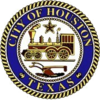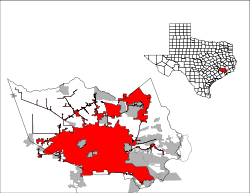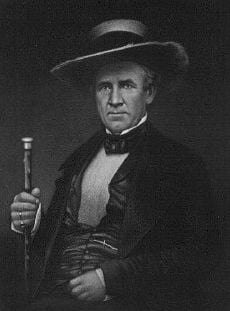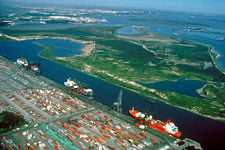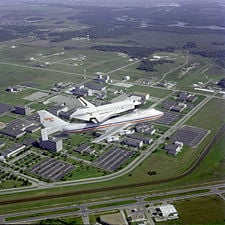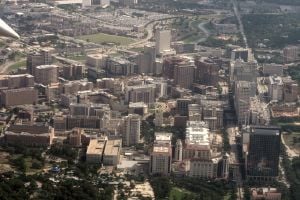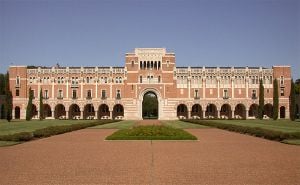Houston, Texas
| Houston | |||
| — City — | |||
| City of Houston | |||
| Downtown Houston skyline | |||
|
|||
| Nickname: Space City (official) | |||
| Houston's location and city limits in Harris County, Texas | |||
| Coordinates: 29°46′N 95°23′W | |||
|---|---|---|---|
| Country | United States of America | ||
| State | Texas | ||
| Counties | Harris, Fort Bend, and Montgomery | ||
| Incorporated | June 5, 1837 | ||
| Government | |||
| - Type | Mayor–council | ||
| - Mayor | Annise Parker | ||
| Area | |||
| - City | 656.3 sq mi (1,699.81 km²) | ||
| - Land | 634.0 sq mi (1,642.05 km²) | ||
| - Water | 22.3 sq mi (57.7 km²) | ||
| Elevation | 43 ft (13 m) | ||
| Population (2010 US Census)[1][2] | |||
| - City | 2,099,451(4th U.S.) | ||
| - Density | 3,623/sq mi (1,505/km²) | ||
| - Urban | 3,822,509 (10th U.S.) | ||
| - Metro | 5,946,800 (5th U.S.) | ||
| - Demonym | Houstonian | ||
| Time zone | CST (UTC-6) | ||
| - Summer (DST) | CDT (UTC-5) | ||
| Area code(s) | 713, 281, 832 | ||
| FIPS code | 48-35000GR2 | ||
| GNIS feature ID | 1380948GR3 | ||
| Website: houstontx.gov | |||
Houston is the fourth-largest city in the United States of America and the largest city in the state of Texas. U.S. Census Bureau tabulations placed the city with an estimated population of nearly 2.2 million inhabitants within the city's area. Houston is composed of 600 square miles (1,600 km²). It is the seat of Harris County and the economic center of the Houston, Sugar Land, Baytown metropolitan area, the sixth-largest in the United States with a population of 5.6 million.
Houston was founded on August 30, 1836 by brothers Augustus Chapman Allen and John Kirby Allen on land near the banks of Buffalo Bayou. The city was incorporated on June 5, 1837 and named after then President of the Republic of Texas, former General Sam Houston, who with the Texas Militia had avenged the Alamo and routed the Mexican Army under Santa Anna at the Battle of San Jacinto. The battle took place 25 miles (40 km) east of where the city was established.
The city is a burgeoning port and railroad industry. Combined with the discovery of oil in 1901, industry has induced continual surges in the city's population. In the mid-twentieth century, Houston became the home of the Texas Medical Center, the world's largest concentration of health-care and research institutions, and the Johnson Space Center, where the NASA's Mission Control Center is located.
Its economy has a broad industrial base in the energy, manufacturing, aeronautics, transportation, and health-care sectors. Only New York City is home to more Fortune 500 headquarters inside the city limits. The Port of Houston ranks first in the United States in international waterborne tonnage handled and second in total cargo tonnage handled.
The Houston Metroplex and 24 surrounding counties possess striking natural beauty, unique biodiversity, and globally important ecological resources. The Armand Bayou Nature Center, for example, preserves wetlands prairie, forest, and marsh habitats of the Texas Gulf Coast.
Geography and cityscape
The city of Houston has a total area of 601.7 square miles (1,558.4 km²). Most of Houston is located on the Gulf coastal plain, and its vegetation is classified as temperate grassland and forest. Much of the city was built on forested land, marshes, swamp, or prairie, which are all still visible in surrounding areas. The flatness of the local terrain, when combined with urban sprawl, has made flooding a recurring problem for the city. Downtown stands about 50 feet (15 m) above sea level, and the highest point in far northwest Houston is about 125 feet (38 m) in elevation. The city once relied on groundwater for its needs, but land subsidence forced the city to turn to ground-level water sources such as Lake Houston and Lake Conroe.
Houston has four major bayous passing through the city. Buffalo Bayou runs through downtown and the Houston Ship Channel, and has three tributaries: White Oak Bayou, which runs through the Heights neighborhood and towards downtown; Braes Bayou, which runs along the Texas Medical Center; and Sims Bayou, which runs through the south of Houston and downtown Houston. The ship channel continues past Galveston and into the Gulf of Mexico.
Climate
Houston's climate is classified as humid subtropical. Spring super cell thunderstorms sometimes bring tornadoes to the area. Prevailing winds are from the south and southeast during most of the year, bringing heat across the continent from the deserts of Mexico and moisture from the Gulf of Mexico.
During the summer months, it is common for the temperature to reach over 90 °F (32 °C), with an average of 99 days per year above 90 °F (32 °C). However, the humidity results in a heat index higher than the actual temperature. Summer mornings average over 90 percent relative humidity and approximately 60 percent in the afternoon. Winds are often light in the summer and offer little relief, except near the immediate coast. To cope with the heat, people use air conditioning in nearly every vehicle and building in the city; in fact, in 1980 Houston was described as the "most air-conditioned place on earth." Scattered afternoon thunderstorms are common in the summer. The hottest temperature ever recorded in Houston was 109 °F (43 °C) on September 4, 2000.
Winters in Houston are fairly temperate. The average high in January, the coldest month, is 63 °F (17 °C), while the average low is 41 °F (5 °C). Snowfall is generally rare. The coldest temperature ever recorded in Houston was 5 °F (−15 °C) on January 23, 1940. Houston receives a high amount of rainfall annually, averaging about 48 inches a year. These rains tend to cause floods over portions of the city.
Cityscape
Locations in Houston are generally classified as either being inside or outside the Interstate 610 Loop. The inside encompasses the central business district and many residential neighborhoods that predate World War II. More recently, high-density residential areas have been developed within the loop. The city's outlying areas, suburbs, and enclaves are located outside of the loop.
Though Houston is the largest city in the United States without formal zoning regulations, it has developed similarly to other Sun Belt cities because the city's land use regulations and legal covenants have played a similar role. Such restrictions have had mixed results. Though some have blamed the city's low density, urban sprawl, and lack of pedestrian-friendliness on these policies, the city's land use has also been credited with a bounty of affordable housing, sparing Houston the worst effects of the 2008 real estate crisis.
Voters rejected efforts to have separate residential and commercial land-use districts in 1948, 1962, and 1993. Consequently, rather than a single central business district as the center of the city's employment, multiple districts have grown throughout the city in addition to downtown.
Houston's skyline has been ranked fourth most impressive in the United States; it is the third-tallest skyline in the United States and one of the top 10 in the world. Houston has a seven-mile (11 km) system of tunnels and skywalks linking buildings in downtown that contain shops, restaurants, and convenience stores. This system enables pedestrians to avoid the intense summer heat and heavy rain showers while walking from one building to another.
A succession of skyscrapers were built throughout the 1970s, culminating with Houston's tallest skyscraper, the 75-floor, 1,002-foot (305 m)-tall JPMorgan Chase Tower (formerly the Texas Commerce Tower), which was completed in 1982. It is the tallest structure in Texas, tenth-tallest building in the United States and the 30th-tallest skyscraper in the world based on height to roof.
History
In August 1836, John Kirby Allen and Augustus Chapman Allen, two real estate entrepreneurs from New York City, purchased 6,642 acres (27 km²) of land along Buffalo Bayou with the intent of founding a city. The Allen brothers decided to name the city after Sam Houston, the popular general at the Battle of San Jacinto, who was elected president of Texas in September 1836.
Houston was granted incorporation on June 5, 1837. In the same year, Houston became the county seat of Harrisburg County (now Harris County) and the temporary capital of the Republic of Texas. In 1840, the community established a chamber of commerce in part to promote shipping and waterborne business at the newly created port on Buffalo Bayou.
By 1860, Houston had emerged as a commercial and railroad hub for the export of cotton. Railroad spurs from inland converged in Houston, where they met rail lines to the ports of Galveston and Beaumont. During the Civil War, Houston served as a headquarters for General John Bankhead Magruder, who used the city as an organization point for the Battle of Galveston. After the Civil War, Houston businessmen initiated efforts to widen the city's extensive system of bayous so the city could accept more commerce between downtown and the nearby port of Galveston. By 1890 Houston was the railroad center of Texas.
In 1900, after Galveston was struck by a devastating hurricane, efforts to make Houston into a viable deep-water port were accelerated. The following year, oil discovered at the Spindletop oil field near Beaumont prompted the development of the Texas petroleum industry. In 1902, President Theodore Roosevelt approved a $1 million improvement project for the Houston Ship Channel. By 1910 the city's population had reached 78,800, almost double that of a decade before.
President Woodrow Wilson opened the deep-water Port of Houston in 1914, seven years after digging began. By 1930, Houston had become Texas's most populous city.
When World War II began, tonnage levels at the port decreased and shipping activities were suspended; however, the war did provide economic benefits for the city. Petrochemical refineries and manufacturing plants were constructed along the ship channel because of the demand for petroleum and synthetic rubber products during the war.
After the war, Houston's economy reverted to being primarily port-driven. In 1948, several unincorporated areas were annexed into the city limits, which more than doubled the city's size, and Houston proper began to spread across the region.
In 1950, the availability of air conditioning provided impetus for many companies to relocate to Houston, resulting in an economic boom and producing a key shift in the city's economy toward the energy sector.
The increased production of the local shipbuilding industry during World War II spurred Houston's growth, as did the establishment in 1961 of NASA's Manned Spacecraft Center (renamed the Lyndon B. Johnson Space Center in 1973), which created the city's aerospace industry. The Astrodome opened in 1965 as the world's first indoor domed sports stadium.
During the late 1970s, Houston experienced a population boom as people from Rust Belt states moved to Texas in large numbers. The new residents came for the numerous employment opportunities in the petroleum industry, created as a result of the Arab oil embargo.
The population boom ended abruptly in the mid-1980s, as oil prices fell precipitously. The space industry also suffered in 1986 after the Space Shuttle Challenger exploded shortly after launch. The late 1980s saw a recession adversely affect the city's economy.
Since the 1990s, as a result of the recession, Houston has made efforts to diversify its economy by focusing on aerospace and health care/biotechnology and by reducing its dependence on the petroleum industry. In 1997, Houstonians elected Lee P. Brown as the city's first African-American mayor.
Houston is the seat of Harris County and the economic center of the Houston–Sugar Land–Baytown metropolitan area—the sixth-largest metropolitan area in the U.S. with a population of 5.6 million.
In June 2001, Tropical Storm Allison dumped up to 37 inches (940 mm) of rain on parts of Houston, causing the worst flooding in the city's history; the storm cost billions of dollars in damage and killed 20 people in Texas. By December of that year, Houston-based energy company Enron collapsed into the second-largest U.S. bankruptcy during an investigation surrounding fabricated partnerships that were allegedly used to hide debt and inflate profits.
In August 2005, Houston became a shelter to more than 150,000 people from New Orleans who evacuated in the wake of Hurricane Katrina. One month later, approximately 2.5 million Houston area residents evacuated when Hurricane Rita approached the Gulf Coast, leaving little damage to the Houston area. This event marked the largest urban evacuation in the history of the United States.
Government and politics
The city of Houston has a strong mayoral form of municipal government. Houston is a home rule city and all municipal elections in the state of Texas are nonpartisan. The City's elected officials are the mayor, city controller and 14 members of the city council. As the result of a 1991 referendum in Houston, a mayor is elected for a two-year term and can be elected to as many as three consecutive terms.
The current city council line-up of nine district-based and five at large positions was based on a U.S. Justice Department mandate that took effect in 1979. At-large council members represent the entire city. Under the current city charter, if the population in the city limits goes past 2.1 million residents, the current nine-member city council districts will be expanded with the addition of two city council districts.
Economy

Houston is recognized worldwide for its energy industry—particularly for oil and natural gas—as well as for biomedical research and aeronautics. The ship channel is also a large part of Houston's economic base.
Five of the six supermajor energy companies maintain a large base of operations in Houston including the international headquarters of ConocoPhillips; US operational headquarters of Exxon-Mobil; US headquarters for international companies Shell Oil (US subsidiary of Royal Dutch Shell located in The Hague, Netherlands), and BP whose international headquarters are in London, England. Chevron has offices in Houston. Houston is also headquarters for the Marathon Oil Corporation, Apache Corporation, and Citgo.
Greater Houston is a leading center for building oilfield equipment. Much of Houston's success as a petrochemical complex is due to its busy man-made ship channel, the Port of Houston. The port ranks first in the United States in international commerce, and is the tenth-largest port in the world. Unlike most places, where high oil and gasoline prices are seen as harmful to the economy, they are generally seen as beneficial for Houston as many are employed in the energy industry.
The Houston–Sugar Land–Baytown MSA's Gross Area Product (GAP) in 2006 was $325.5 billion,[4] slightly larger than Austria’s, Poland’s, or Saudi Arabia’s Gross Domestic Product (GDP). When comparing Houston's economy to a national economy, only 21 countries other than the United States have a gross domestic product exceeding Houston's regional gross area product. Mining, which in Houston is almost entirely exploration and production of oil and gas, accounts for 11 percent of Houston's GAP; this is down from 21 percent in 1985. The reduced role of oil and gas in Houston's GAP reflects the rapid growth of other sectors, such as engineering services, health services, and manufacturing.[5]
Among the 10 most populous metro areas in the U.S., Houston posted both the highest employment growth rate and the largest nominal employment gain in period September 2007 through September 2008.[6] The unemployment rate in the city was 3.8 percent in April 2008, the lowest level in eight years while the job growth rate was 2.8 percent.
In 2006, the Houston metropolitan area ranked first in Texas and third in the U.S. within the Category of "Best Places for Business and Careers" by Forbes Magazine. Forty foreign governments maintain trade and commercial offices here and the city has 23 active foreign chambers of commerce and trade associations. Twenty foreign banks representing ten nations operate in Houston, providing financial assistance to the international community.
In 2008, Houston received top ranking on Kiplinger's Personal Finance Best Cities of 2008 list, which ranks cities on their local economy, employment opportunities, reasonable living costs and quality of life. The city ranked fourth for highest increase in the local technological innovation over the preceding 15 years, according to Forbes Magazine. In the same year, the city ranked second on the annual Fortune 500 list of company headquarters and ranked first for Forbes Best Cities for College Graduates.
Transportation
Houston's freeway system is made up of 575.5 miles (926.2 km) of freeways and expressways in a ten-county metropolitan area. Its highway system uses a hub-and-spoke freeway structure serviced by multiple loops. Houston also lies along the route of the proposed Interstate 69 NAFTA superhighway that would link Canada, the U.S. industrial Midwest, Texas, and Mexico.
Houston is served by two commercial airports, serving 52 million passengers in 2007.[7] The larger is George Bush Intercontinental Airport (IAH), which in 2007 was the ninth-busiest in the United States for total passengers, and sixteenth-busiest worldwide.[8] In 2006, the United States Department of Transportation named IAH the fastest-growing of the top ten airports in the United States. The second-largest commercial airport in Houston is William P. Hobby Airport (named Houston International Airport until 1967). The airport operates primarily small to medium-haul flights and is the only airport in Houston served by Southwest Airlines and JetBlue Airways.
Demographics
Houston is a diverse and international city, in part because of its many academic institutions and strong industries. Houston has among the youngest populations in the nation, partly due to an influx of immigrants into Texas.
Over 90 languages are spoken in the city. The city has the third-largest Hispanic and third-largest Mexican-American population in the United States.[9] An estimated 400,000 illegal immigrants are believed to reside in the Greater Houston area.[10]
Houston has one of the largest communities of Indian-Americans and Pakistani-Americans in the United States, as well as a large population of immigrants from elsewhere in Asia, including the largest Vietnamese-American population in Texas and third-largest in the United States, with 85,000 people in 2006.[11]
As of the 2000 census, there were 1,953,631 people and the population density was 3,371.7 people per square mile (1,301.8/km²). The racial makeup of the city was 49.27 percent white, 25.31 percent African American, 5.31 percent Asian, 0.44 percent Native American, 0.06 percent Pacific Islander, 16.46 percent from some other race, and 3.15 percent from two or more races. Persons of Hispanic origin—who may be of any race—accounted for 37 percent of the population while non-Hispanic whites made up 30.8 percent.
While nonviolent crime in the city dropped by two percent in 2005 compared to 2004, the number of homicides rose by 23.5 percent. Since 2005, Houston has been experiencing a spike in crime, which observers say is due in part to an influx of people from New Orleans following Hurricane Katrina. After Katrina, Houston's murder rate increased 70 percent in November and December 2005, compared to levels in 2004.
Health care
Houston is the seat of the internationally renowned Texas Medical Center, which contains the world's largest concentration of research and health-care institutions. All 45 member institutions of the Texas Medical Center are non-profit organizations. They provide patient and preventive care, research, education, and local, national, and international community well-being. These institutions include 13 renowned hospitals and two specialty institutions, two medical schools, four nursing schools, and schools of dentistry, public health, pharmacy, and virtually all health-related careers. It is where one of the first—and still the largest—air emergency service, Life Flight, was created, and a very successful inter-institutional transplant program was developed. More heart surgeries are performed at the Texas Medical Center than anywhere else in the world.[12]
Some of the academic and research health institutions in the center include Baylor College of Medicine, The University of Texas Health Science Center at Houston, The Methodist Hospital, Texas Children's Hospital, and The University of Texas M. D. Anderson Cancer Center. The latter has consistently ranked as one of the top two U.S. hospitals specializing in cancer care since 1990.
Education
There are four public and three private universities engaged in research and development in Houston. The University of Houston ("UH") is Texas's third-largest public research university with more than 40 research centers and institutes. With more than 36,000 students from 130 countries, UH is one of the most ethnically diverse campuses in the country.
The city is also the home to Rice University, one of the leading teaching and research universities of the United States and ranked the nation's 17th-best overall university by U.S. News & World Report.[13] Other public institutions of higher learning in the city include University of Houston–Clear Lake ("UHCL"), University of Houston–Downtown ("UHD"), and Texas Southern University ("TSU"). The several private institutions include University of St. Thomas, which in 2008 was ranked one of "America's Best Colleges" by US News & World Report, and Houston Baptist University. The Houston Community College System serves most of Houston and is the fourth-largest community college system in the United States.
There are 17 school districts serving the city. The Houston Independent School District (HISD) is the seventh-largest in the United States. HISD has 112 campuses that serve as magnet or vanguard schools—specializing in such disciplines as health professions, visual and performing arts, and the sciences. There are also many charter schools that are run separately from school districts. In addition, some public school districts also have their own charter schools.
The Houston area is home to more than 300 private schools. The Houston Area Independent Schools, or HAIS, offer education from a variety of different religious as well as secular viewpoints. The Houston area Catholic schools are operated by the Archdiocese of Galveston-Houston.
Culture
Houston has an active visual and performing arts scene. The Theater District is located downtown and is home to nine major performing arts organizations and six performance halls. Houston is one of few United States cities with permanent, professional, resident companies in all major performing arts disciplines: opera (Houston Grand Opera), ballet (Houston Ballet), music (Houston Symphony Orchestra), and theater (The Alley Theatre). Houston is also home to many local folk artists, art groups, and various smaller progressive arts organizations.
Houston holds the Bayou City Art Festival[14] in October, which is considered to be one of the top five art festivals in the United States.
The Museum District has many popular cultural institutions and exhibits, which attract more than 7 million visitors a year.[15] Notable facilities located in the district include the Museum of Fine Arts, Houston Museum of Natural Science, the Contemporary Arts Museum Houston, Holocaust Museum Houston, and the Houston Zoo.
Bayou Bend, located in River Oaks, is a 14-acre (5.7 ha) facility of the Museum of Fine Arts that houses one of America's best collections of decorative art, paintings and furniture.
Many annual events celebrate the diverse cultures of Houston. The largest and longest running is the annual Houston Livestock Show and Rodeo, held over 20 days from late February to early March. Another large celebration is the annual night-time Houston Pride Parade, held at the end of June. Other annual events include the Houston Greek Festival, Art Car Parade, the Houston Auto Show, the Houston International Festival and the Westheimer Block Party.
Tourism and recreation
Space Center Houston is the official visitors’ center of NASA's Lyndon B. Johnson Space Center, where one finds many interactive exhibits including moon rocks, a shuttle simulator, and presentations about the history of NASA's manned space flight program.
Houston is home to 337 parks including Hermann Park, which houses the Houston Zoo and the Houston Museum of Natural Science. The Museum district features 18 museums.[16] Of the ten most populous U.S. cities, Houston has the most total area of parks and green space: 56,405 acres (228 km²). The city also has over 200 additional green spaces—totaling over 19,600 acres (79 km²) that are managed by the city—including the Houston Arboretum and Nature Center. The Houston Civic Center was replaced by the George R. Brown Convention Center—one of the nation's largest—and the Jesse H. Jones Hall for the Performing Arts, home of the Houston Symphony Orchestra and Society for the Performing Arts. The Sam Houston Coliseum and Music Hall have been replaced by the Hobby Center for the Performing Arts.
Sports
Houston has teams for nearly every major professional sport. The Houston Astros (MLB), Houston Texans (NFL), Houston Rockets (NBA), Houston Dynamo (MLS), Houston Comets (WNBA), Houston Aeros (AHL), Houston Wranglers (WTT), Houston Takers (ABA), Houston Energy (IWFL), and the H-Town Texas Cyclones (NWFA) all call Houston home.
The city has the Reliant Astrodome, the first domed stadium in the world; it also holds the NFL's first retractable-roof stadium, Reliant Stadium.
Looking to the future
Houston has excessive ozone levels and is ranked among the most ozone-polluted cities in the United States. Ground-level ozone, or smog, is Houston’s predominant air pollution problem, with the American Lung Association rating the metropolitan area's ozone level as the sixth worst in the United States in 2006. The industries located along the ship channel are a major cause of the pollution.
Still, the city is making efforts to be more "green." It is the largest municipal purchaser of renewable energy in the nation, purchasing over 350 million kWh of wind energy. Solar panels are now in use at two city facilities.
The city is using an innovative technology to improve the quality of drinking water, saving energy and costly chemical treatments. And it is using state-of-the-art infrared cameras and a mobile air monitoring lab to target and stop harmful emissions. In 2008 the city had over 500 hybrid vehicles in use, including a hybrid dump truck.
Houston has a seven-mile (11 km) system of tunnels and skywalks linking buildings in downtown that contain shops, restaurants, and convenience stores. This system enables pedestrians to avoid the intense summer heat and heavy rain showers while walking from one building to another.
The percentage of the city's population that is Hispanic (of all races) increased between 1990 and 2000 from 26 to 37 percent, but the percentage of school-age children rose even more dramatically, to 50 percent of those in nursery school or kindergarten and 44 percent of those in grades 1-12. This growing young population is likely to affect the city's needs and policies in coming years.
Notes
- ↑ Houston city, Texas, US Census. US Census. Retrieved January 2, 2010.
- ↑ Texas by Place - GCT-T1-R. Census. US Census. Retrieved January 3, 2010.
- ↑ CityData.com. Houston: Economy Retrieved December 4, 2008.
- ↑ Greater Houston Partnership. April 22, 2008. Houston Area Profile Retrieved December 4, 2008.
- ↑ Greater Houston Partnership. May 21, 2008. Gross Area Product by Industry Retrieved December 4, 2008.
- ↑ Greater Houston Partnership. October 29, 2008. Employment by Industry Retrieved December 4, 2008.
- ↑ Houston Airport System. January 28, 2008. 52 Million Travelers and Over 387,000 Metric Tons of Air Cargo Passed through Houston’s Airports in 2007 Retrieved December 4, 2008.
- ↑ Airports Council International. July 2008. Top 30 World Airports by Passenger. Retrieved December 4, 2008.
- ↑ U.S. Census Bureau. May 10, 2001. Census 2000 Paints Statistical Portrait of the Nation's Hispanic Population.
- ↑ Edward Hegstrom, February 21, 2006. Shadows Cloaking Immigrants Prevent Accurate Count Houston Chronicle. Retrieved December 4, 2008.
- ↑ My-Thuan Tran, December 21, 2007. Flocking from SoCal to Houston Los Angeles Times. Retrieved December 4, 2008.
- ↑ Greater Houston Convention and Visitors Bureau. Texas Medical Center Retrieved December 4, 2008.
- ↑ U.S. News & World Report, May 4, 2007. America's Best Colleges 2007 Retrieved December 4, 2008.
- ↑ Bayou City Art Festival. Retrieved December 29, 2008.
- ↑ Greater Houston Convention and Visitors Bureau.Houston Museum District. Retrieved December 4, 2008.
- ↑ Houston Museum District. Retrieved December 29, 2008.
ReferencesISBN links support NWE through referral fees
- Allen, O. Fisher. 1936. City of Houston from Wilderness to Wonder. Self Published. NA. .
- Glaeser, Edward L. Houston, New York Has a Problem.The Manhattan Institute. Retrieved December 12, 2008.
- Houston History. WELCOME to HOUSTON HISTORY. Retrieved December 12, 2008.
- Johnston, Marguerite. 1991. Houston, The Unknown City, 1836–1946. Texas A&M University Press. ISBN 0890964769.
- Miller, Ray. 1984. Ray Miller's Houston. Gulf Publishing Company. ISBN 088415081X.
- Slotboom, Oscar F. "Erik." 2003. Houston Freeways. [1]. Oscar F. Slotboom. ISBN 0974160539.
- Wilson, Ann Quin. 1982. Native Houstonian - A Collective Portrait. The Donning Company - Houston Baptist University Press.
- Young, S.O. June 1912. A thumb-nail history of the city of Houston, Texas, from its founding in 1836 to the year 1912 University of North Texas. Retrieved December 12, 2008.
- Young, S.O. 1913. True stories of old Houston and Houstonians: historical and personal sketches University of North Texas. Retrieved December 12, 2008.
External links
All links retrieved July 19, 2024.
- City of Houston official website
- Houston History
- Greater Houston Convention & Visitors Bureau
- Greater Houston Partnership
- Greater Houston Transportation and Emergency Management Center
- Uptown Houston District
- Midtown Houston District
- Houston Airport System
- Houston Wilderness Organization
Credits
New World Encyclopedia writers and editors rewrote and completed the Wikipedia article in accordance with New World Encyclopedia standards. This article abides by terms of the Creative Commons CC-by-sa 3.0 License (CC-by-sa), which may be used and disseminated with proper attribution. Credit is due under the terms of this license that can reference both the New World Encyclopedia contributors and the selfless volunteer contributors of the Wikimedia Foundation. To cite this article click here for a list of acceptable citing formats.The history of earlier contributions by wikipedians is accessible to researchers here:
The history of this article since it was imported to New World Encyclopedia:
Note: Some restrictions may apply to use of individual images which are separately licensed.


